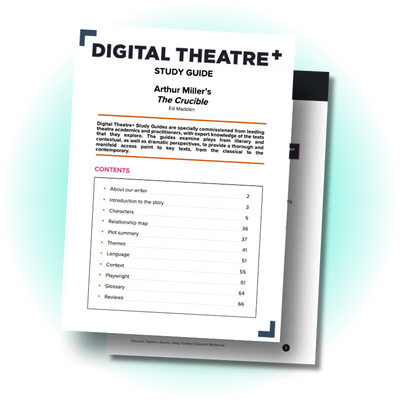Teach The Crucible
Written by Arthur Miller in 1953, The Crucible is a four-act play that responds to the US Government's banishment of communists, and is a gripping dramatisation of the 17th century Salem witch trials.
Digital Theatre+ helps you bring The Crucible to life in the classroom with high-quality productions, lesson plans, interactive resources, and more...
Richard Armitage as John Proctor in The Crucible (© Jay Brooks)
Explore The Crucible on Digital Theatre+
- 2Productions
- 15Video resources
- 19Written resources
Light up your classroom with engaging resources made by teachers, for teachers. Get in touch for a complete overview.
|
|
The Old Vic, 2014 Digital Theatre captured this 2014 The Crucible production live at London's Old Vic Theatre. It was directed by Yaël Farber (King Lear, Hamlet, My Brilliant Friend) and stars Richard Armitage as John Proctor. "Farber preserves the integrity of Miller's language while investing the action with a raw, visceral power." – The Guardian ★★★★★
|
|
|
L.A. Theatre Works, 1988 Recorded at Culver Studios, this audio production was directed by Martin Jenkins, and stars Stacy Keach as John Proctor and Richard Dreyfuss as Reverand John Hale. "The words are this production's top priority – and it treats them with the respect they deserve." – LA Times
|
Interviews & Documentaries
- Arthur Miller
- On Directing: Yaël Farber
- On Acting: Richard Armitage (John Proctor)
- On Acting: Adrian Schiller (Reverand John Proctor)
- On Acting: Anna Madeley (Elizabeth Proctor)
E-learning Videos
- Unlocking Language in The Crucible
- Unlocking Structure in The Crucible
- Unlocking Literary Devices in The Crucible
Essays
- A Concise Introduction to Arthur Miller
- The Crucible: A Critical Introduction
Study Guides
- The Crucible
- Unlocked: The Crucible
Teaching Guides
- Discover, Explore, Assess
- Plays through Practice
- US Theatre Toolkit
The Crucible Lesson Plans
- Exploring the Life and Works of Arthur Miller
- Understanding John Proctor's Character Development
- Analyzing the Theme of Reputation

What is The Crucible about?
A small village in colonial Massachusetts is suddenly thrown into chaos following an accusation of witchcraft from the daughters.
A partially fictionalized retelling of the 1692-93 Salem witch trials, the townsfolk of Miller's play are forced to choose between their reputations and their integrity as hysteria begins to spiral out of control.
Filled with authentic characters, memorable speeches, and a call to defy tyranny in all its forms, the play has grown increasingly popular with actors, directors, and theatre companies wishing to take a public stance against mob rule and/or autocratic tendencies (especially fueled by religion or politics).
Explore Key Themes & Characters
Turn passive learning into active engagement with fun and dynamic resources on core literary texts like The Crucible, including in-depth analysis of key themes, characters, and literary techniques. Explore the full DT+ library with a free trial.
Hysteria has two meanings: to suffer from an uncontrollable, over-the-top amount of an emotion or an old-fashioned term for a psychological disorder caused by severe stress.
We see both definitions in The Crucible: Betty begins the play sick in bed, leading the other girls to act hysterically. And meanwhile, fear in the community grows out of control, leading to a form of 'mass hysteria'.
Many of the characters in the play are driven by different types of fear: fear of each other, fear of the law, and fear of God.
These different types of fear work together and build to hysteria and chaos in the community.
In Salem, a good reputation was one of the most important things you could have. It would shape the way people talked about you and influence your daily life in a variety of ways.
For this reason, almost all of the characters of the play will go above and beyond to protect their reputation.
In The Crucible, characters are forced to lie to save themselves from punishment. They admit to crimes they have never committed or conceal information to avoid unfair judgments.
This is the bizarre nature of Salem's society at the time: lies and secrets bubble under the surface of the play, and add to the tension as the play progresses.
In the 17th century period of the play, Salem is a theocratic society, which means that the church and state are one and the same: justice and religion are very much intertwined.
This is why the status of the characters' individual souls becomes a matter of public concern for the town and for the court, and why there is very little room for argument.
"How may I live without my name? I have given you my soul; leave me my name!" (Proctor, Act 4)
John Proctor is a farmer in his mid-30s who might best be defined by his sense of pride (and perhaps his shame).
He is respected and perhaps feared by Salem society - he has a particularly public dislike for Reverand Parris, but privately, his marriage has been difficult since the affair with Abigail.
"There are them that cannot sing, and them that cannot weep - my wife cannot lie. I have paid much to learn it, sir." (Proctor, Act 3)
Elizabeth is the wife of John Proctor, and is a woman of good renown in Salem.
When her name is first raised in court in connection with witchcraft, the accusation is not pursued, and later she is one of the wives in support of whom Giles Corey is able to gather 91 signatures.
"And now you bid me tear the light out of my eyes? I will not, I cannot!" (Abigail, Act 2)
Abigail Williams is the niece of Reverand Parris, and is described as "a strikingly beautiful girl".
She is portrayed as being in love with - or at least obsessed with - John Proctor, and is driven by this obsession. Abigail hates that Proctor will not continue this affair.
"I may shut my conscience to it no more - private vengeance is working through this testimony." (Reverand Hale, Act 3)
Reverand Hale is a young minister from Beverly, considered to be an expert on witchcraft and demonic arts.
He is first introduced to us as a man of absolute self-certainty who is proud to be doing God's work by hunting out witches. As the trials continue, he begins to lose this confidence.
"This is the highest court of the supreme government of this province, do you know it?" (Danforth, Act 3)
Danforth is the most senior official in the play, the Deputy-Governor of Massachusetts.
He presides over witchcraft trials not only in Salem but throughout the state, and his conviction in the law and unswerving belief that God will protect the innocent mean he has no qualms in sentencing those who will not confess to be hanged.
This overview is taken from our Unlocked Study Guide, which covers key context, characters, themes, and literary devices of the text.
Who is Arthur Miller?
Arthur Miller (1915-2005) was an American playwright, screenwriter, and essayist, best known for his modern tragedies Death of a Salesman (1949) and The Crucible (1953), characterized by an interrogation of the nature of the American Dream in post-war society.
In a career spanning six decades, Miller wrote more than 30 works for theatre, as well as various radio plays and screenplays, several works of fiction, and a highly acclaimed memoir.
Extract: A Concise Introduction to Arthur Miller on DT+.
What is 'Hysteria'?
Develop your students understanding of hysteria in The Crucible with this free e-learning video. This video is part of the Unlocked: The Crucible series, a collection of short, accessible e-learning videos designed to strengthen understanding of the text.
The Crucible: Lesson Toolkit
Immerse your students in the world of The Crucible (and save precious planning time) with this ready-to-go 60-minute Lesson Toolkit. Complete with eight dynamic exercises that explore core ELA skills, and fresh teaching approaches to help engage modern High School students.
Teaching Tragic Heroes | On-Demand Course
Hear from the experts as they examine tragic literature's best-known 'heroes' in this two-hour on-demand PD course. Includes sessions on The Crucible's dynamic protagonist, John Proctor.














